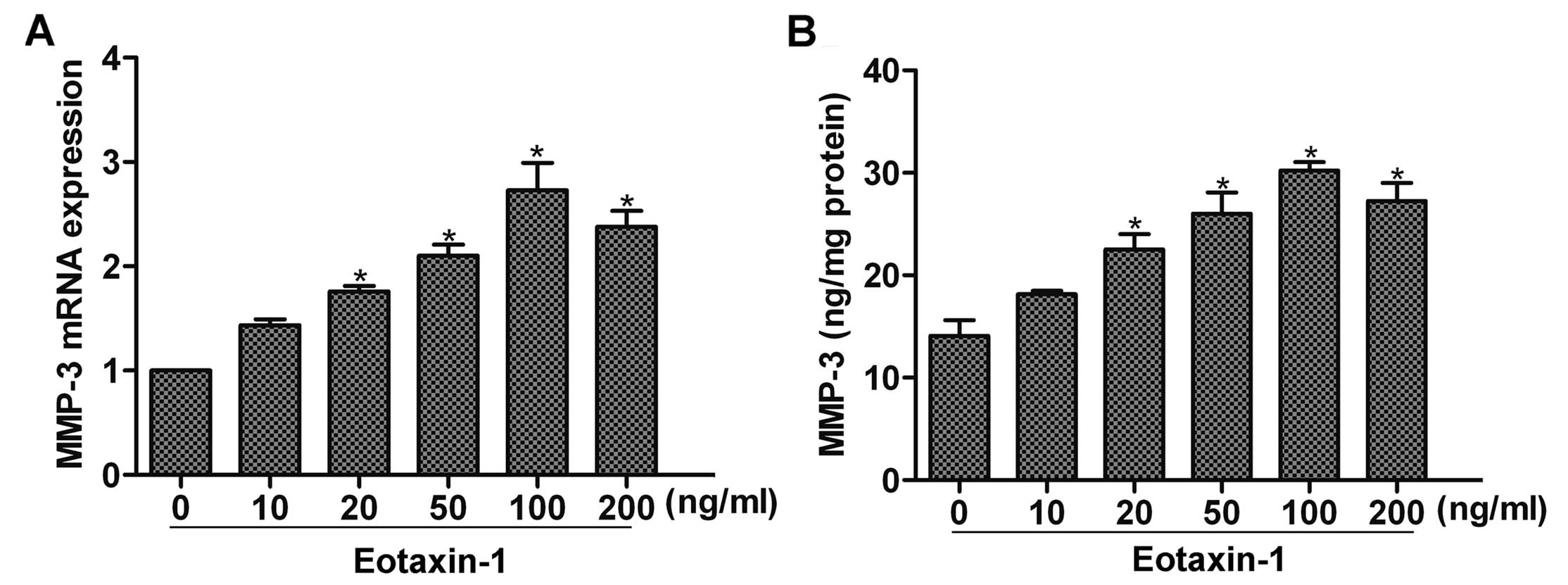|
1
|
Siegel R, Naishadham D and Jemal A: Cancer
statistics, 2013. CA Cancer J Clin. 63:11–30. 2013. View Article : Google Scholar
|
|
2
|
Chung LWK, Baseman A, Assikis V and Zhau
HE: Molecular insights into prostate cancer progression: the
missing link of tumor microenvironment. J Urol. 173:10–20. 2005.
View Article : Google Scholar : PubMed/NCBI
|
|
3
|
Harlozinska A: Progress in molecular
mechanisms of tumor metastasis and angiogenesis. Anticancer Res.
25:3327–3333. 2005.PubMed/NCBI
|
|
4
|
Menzies-Gow A, Ying S, Sabroe I, et al:
Eotaxin (CCL11) and eotaxin-2 (CCL24) induce recruitment of
eosinophils, basophils, neutrophils, and macrophages as well as
features of early- and late-phase allergic reactions following
cutaneous injection in human atopic and nonatopic volunteers. J
Immunol. 169:2712–2718. 2002. View Article : Google Scholar
|
|
5
|
Campbell EM, Kunkel SL, Strieter RM and
Lukacs NW: Temporal role of chemokines in a murine model of
cockroach allergen-induced airway hyperreactivity and eosinophilia.
J Immunol. 161:7047–7053. 1998.PubMed/NCBI
|
|
6
|
Yawalkar N, Uguccioni M, Schärer J, et al:
Enhanced expression of eotaxin and CCR3 in atopic dermatitis. J
Invest Dermatol. 113:43–48. 1999. View Article : Google Scholar : PubMed/NCBI
|
|
7
|
Nolen BM and Lokshin AE: Targeting CCL11
in the treatment of ovarian cancer. Expert Opin Ther Targets.
14:157–167. 2010. View Article : Google Scholar : PubMed/NCBI
|
|
8
|
Uguccioni M, Mackay CR, Ochensberger B, et
al: High expression of the chemokine receptor CCR3 in human blood
basophils. Role in activation by eotaxin, MCP-4, and other
chemokines. J Clin Invest. 100:1137–1143. 1997. View Article : Google Scholar : PubMed/NCBI
|
|
9
|
Miyagaki T, Sugaya M, Murakami T, et al:
CCL11-CCR3 interactions promote survival of anaplastic large cell
lymphoma cells via ERK1/2 activation. Cancer Res. 71:2056–2065.
2011. View Article : Google Scholar : PubMed/NCBI
|
|
10
|
Levina V, Nolen BM, Marrangoni AM, et al:
Role of eotaxin-1 signaling in ovarian cancer. Clin Cancer Res.
15:2647–2656. 2009. View Article : Google Scholar : PubMed/NCBI
|
|
11
|
Agarwal M, He C, Siddiqui J, Wei JT and
Macoska JA: CCL11 (eotaxin-1): a new diagnostic serum marker for
prostate cancer. Prostate. 73:573–581. 2013. View Article : Google Scholar : PubMed/NCBI
|
|
12
|
Chao PZ, Hsieh MS, Cheng CW, Lin YF and
Chen CH: Regulation of MMP-3 expression and secretion by the
chemokine eotaxin-1 in human chondrocytes. J Biomed Sci. 18:862011.
View Article : Google Scholar : PubMed/NCBI
|
|
13
|
Lein M, Nowak L, Jung K, Koenig F, Schnorr
D and Loening SA: Metalloproteinases (MMP-1, MMP-3) and their
inhibitors (TIMP) in blood plasma of patients with prostate
carcinoma. Urologe A. 37:377–381. 1998.(In German).
|
|
14
|
Zhu G, Zhou J, Song W, et al: Role of
GLI-1 in epidermal growth factor-induced invasiveness of ARCaPE
prostate cancer cells. Oncol Rep. 30:904–910. 2013.PubMed/NCBI
|
|
15
|
Kodali RB, Kim WJ, Galaria II, et al:
CCL11 (Eotaxin) induces CCR3-dependent smooth muscle cell
migration. Arterioscler Thromb Vasc Biol. 24:1211–1216. 2004.
View Article : Google Scholar : PubMed/NCBI
|
|
16
|
Salcedo R, Young HA, Ponce ML, et al:
Eotaxin (CCL11) induces in vivo angiogenic responses by human
CCR3+ endothelial cells. J Immunol. 166:7571–7578. 2001.
View Article : Google Scholar : PubMed/NCBI
|
|
17
|
Muessel MJ, Scott KS, Friedl P, Bradding P
and Wardlaw AJ: CCL11 and GM-CSF differentially use the Rho GTPase
pathway to regulate motility of human eosinophils in a
three-dimensional microenvironment. J Immunol. 180:8354–8360. 2008.
View Article : Google Scholar : PubMed/NCBI
|
|
18
|
Georgiou GK, Igglezou M, Sainis I, et al:
Impact of breast cancer surgery on angiogenesis circulating
biomarkers: a prospective longitudinal study. World J Surg Oncol.
11:2132013. View Article : Google Scholar : PubMed/NCBI
|
|
19
|
Jöhrer KK, Zelle-Rieser C, Perathoner A,
et al: Up-regulation of functional chemokine receptor CCR3 in human
renal cell carcinoma. Clin Cancer Res. 11:2459–2465.
2005.PubMed/NCBI
|
|
20
|
Kouno J, Nagai H, Nagahata T, et al:
Up-regulation of CC chemokine, CCL3L1, and receptors, CCR3, CCR5 in
human glioblastoma that promotes cell growth. J Neurooncol.
70:301–307. 2004. View Article : Google Scholar : PubMed/NCBI
|
|
21
|
Wang H, Wittchen ES, Jiang Y, Ambati B,
Grossniklaus HE and Hartnett ME: Upregulation of CCR3 by
age-related stresses promotes choroidal endothelial cell migration
via VEGF-dependent and -independent signaling. Invest Ophthalmol
Vis Sci. 52:8271–8277. 2011. View Article : Google Scholar : PubMed/NCBI
|
|
22
|
Markwick LJ, Clements D, Roberts ME,
Ceresa CC, Knox AJ and Johnson SR: CCR3 induced-p42/44 MAPK
activation protects against staurosporine induced-DNA fragmentation
but not apoptosis in airway smooth muscle cells. Clin Exp Allergy.
42:1040–1050. 2012. View Article : Google Scholar : PubMed/NCBI
|
|
23
|
Reddy KB, Nabha SM and Atanaskova N: Role
of MAP kinase in tumor progression and invasion. Cancer Metastasis
Rev. 22:395–403. 2003. View Article : Google Scholar : PubMed/NCBI
|
|
24
|
Chakraborti S, Mandal M, Das S, Mandal A
and Chakraborti T: Regulation of matrix metalloproteinases: an
overview. Mol Cell Biochem. 253:269–285. 2003. View Article : Google Scholar : PubMed/NCBI
|
|
25
|
Hsu YH, Hsieh MS, Liang YC, et al:
Production of the chemokine eotaxin-1 in osteoarthritis and its
role in cartilage degradation. J Cell Biochem. 93:929–939. 2004.
View Article : Google Scholar : PubMed/NCBI
|
|
26
|
Bachmeier BE, Nerlich AG, Lichtinghagen R
and Sommerhoff CP: Matrix metalloproteinases (MMPs) in breast
cancer cell lines of different tumorigenicity. Anticancer Res.
21:3821–3828. 2001.PubMed/NCBI
|















